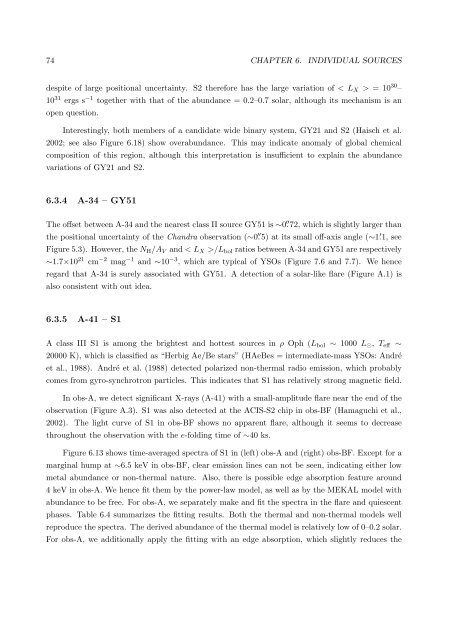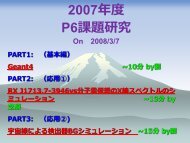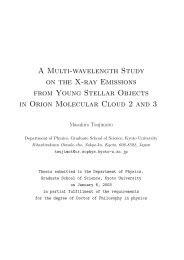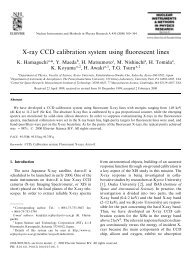X-ray Study of Low-mass Young Stellar Objects in the ρ Ophiuchi ...
X-ray Study of Low-mass Young Stellar Objects in the ρ Ophiuchi ...
X-ray Study of Low-mass Young Stellar Objects in the ρ Ophiuchi ...
Create successful ePaper yourself
Turn your PDF publications into a flip-book with our unique Google optimized e-Paper software.
74 CHAPTER 6. INDIVIDUAL SOURCESdespite <strong>of</strong> large positional uncerta<strong>in</strong>ty. S2 <strong>the</strong>refore has <strong>the</strong> large variation <strong>of</strong> < L X > = 10 30 –10 31 ergs s −1 toge<strong>the</strong>r with that <strong>of</strong> <strong>the</strong> abundance = 0.2–0.7 solar, although its mechanism is anopen question.Interest<strong>in</strong>gly, both members <strong>of</strong> a candidate wide b<strong>in</strong>ary system, GY21 and S2 (Haisch et al.2002; see also Figure 6.18) show overabundance. This may <strong>in</strong>dicate anomaly <strong>of</strong> global chemicalcomposition <strong>of</strong> this region, although this <strong>in</strong>terpretation is <strong>in</strong>sufficient to expla<strong>in</strong> <strong>the</strong> abundancevariations <strong>of</strong> GY21 and S2.6.3.4 A-34 – GY51The <strong>of</strong>fset between A-34 and <strong>the</strong> nearest class II source GY51 is ∼0. ′′ 72, which is slightly larger than<strong>the</strong> positional uncerta<strong>in</strong>ty <strong>of</strong> <strong>the</strong> Chandra observation (∼0. ′′ 5) at its small <strong>of</strong>f-axis angle (∼1. ′ 1, seeFigure 5.3). However, <strong>the</strong> N H /A V and < L X >/L bol ratios between A-34 and GY51 are respectively∼1.7×10 21 cm −2 mag −1 and ∼10 −3 , which are typical <strong>of</strong> YSOs (Figure 7.6 and 7.7). We henceregard that A-34 is surely associated with GY51. A detection <strong>of</strong> a solar-like flare (Figure A.1) isalso consistent with out idea.6.3.5 A-41 – S1A class III S1 is among <strong>the</strong> brightest and hottest sources <strong>in</strong> <strong>ρ</strong> Oph (L bol ∼ 1000 L ⊙ , T eff ∼20000 K), which is classified as “Herbig Ae/Be stars” (HAeBes = <strong>in</strong>termediate-<strong>mass</strong> YSOs: Andréet al., 1988). André et al. (1988) detected polarized non-<strong>the</strong>rmal radio emission, which probablycomes from gyro-synchrotron particles. This <strong>in</strong>dicates that S1 has relatively strong magnetic field.In obs-A, we detect significant X-<strong>ray</strong>s (A-41) with a small-amplitude flare near <strong>the</strong> end <strong>of</strong> <strong>the</strong>observation (Figure A.3). S1 was also detected at <strong>the</strong> ACIS-S2 chip <strong>in</strong> obs-BF (Hamaguchi et al.,2002). The light curve <strong>of</strong> S1 <strong>in</strong> obs-BF shows no apparent flare, although it seems to decreasethroughout <strong>the</strong> observation with <strong>the</strong> e-fold<strong>in</strong>g time <strong>of</strong> ∼40 ks.Figure 6.13 shows time-averaged spectra <strong>of</strong> S1 <strong>in</strong> (left) obs-A and (right) obs-BF. Except for amarg<strong>in</strong>al hump at ∼6.5 keV <strong>in</strong> obs-BF, clear emission l<strong>in</strong>es can not be seen, <strong>in</strong>dicat<strong>in</strong>g ei<strong>the</strong>r lowmetal abundance or non-<strong>the</strong>rmal nature. Also, <strong>the</strong>re is possible edge absorption feature around4 keV <strong>in</strong> obs-A. We hence fit <strong>the</strong>m by <strong>the</strong> power-law model, as well as by <strong>the</strong> MEKAL model withabundance to be free. For obs-A, we separately make and fit <strong>the</strong> spectra <strong>in</strong> <strong>the</strong> flare and quiescentphases. Table 6.4 summarizes <strong>the</strong> fitt<strong>in</strong>g results. Both <strong>the</strong> <strong>the</strong>rmal and non-<strong>the</strong>rmal models wellreproduce <strong>the</strong> spectra. The derived abundance <strong>of</strong> <strong>the</strong> <strong>the</strong>rmal model is relatively low <strong>of</strong> 0–0.2 solar.For obs-A, we additionally apply <strong>the</strong> fitt<strong>in</strong>g with an edge absorption, which slightly reduces <strong>the</strong>

















